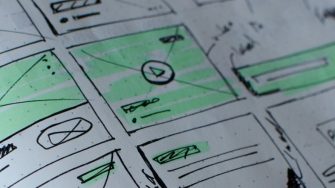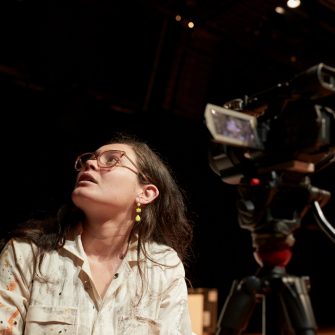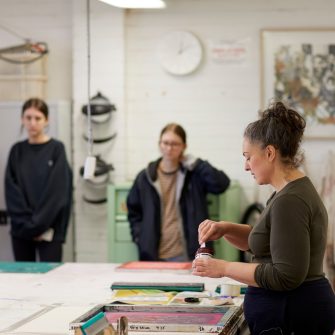Master of Public Relations & Advertising / Master of Design
- Commencing Terms
- Term 1, 2 & 3
- Duration
- 3 Year(s)
- Delivery Mode
- Face-to-face (includes blended)
- Campus
-
Paddington
- Codes
- Program code 8234
- CRICOS code 094951G
-
2026 Indicative first year full fee
- $37,500*
-
2026 Indicative full fee to complete degree
- $111,000*
-
2026 Indicative first year full fee
- $50,000*
-
2026 Indicative full fee to complete degree
- $159,500*

Application closures for 2026
Undergraduate programs for 2026 intakes are closed for New Overseas Student Commencement (NOSC) applications. Applications for postgraduate programs remain open. Find out if this closure applies to you.
- Overview
- Entry requirements
- What will I study?
- Future careers
- How to apply
- Fees & Scholarships
Overview
The UNSW Master of Public Relations & Advertising/Master of Design combines two postgraduate degrees over two or three years full-time. You’ll gain a unique combination of strategic communication skills and design practice, as well as a deep conceptual knowledge of media theory and design research.
The Master of Public Relations and Advertising/Design dual award is ideal for industry professionals from advertising or design seeking to advance their career, as well as career-changers wanting to enter vibrant and rapidly evolving industries. Graduates of this program are well-rounded communication professionals known for creativity, design thinking and entrepreneurship.
Key features
Use the latest media and design technology
You’ll prepare to lead design innovation and creative approaches in the industry. Our digital facilities contain the most current technologies, including media production equipment and advanced design software, through which you can hone your design practice and strategic communication skills.
Specialised design studio practice
The Master of Design allows you to focus your studio-based courses on a specific area of design and digital media or to put together a suite of courses. Areas of practice include Graphic Communication, Spatial Experiences, Interaction Design and User Experience (UX) Design, Visualisation and Visual Effects and Future Making: Materials and Objects.
Build the right networks
Our strong industry connections can help you undertake real-world learning through placements and establish networks to boost your career. UNSW’s focus on entrepreneurship provides programs and facilities to nurture start-up aspirations alongside our strong ties to larger media organisations.
Deep critical thinking
Our programs are led by academics with extensive years of industry experience. They’ll guide you to think critically about methodologies and contemporary theories, including design thinking, advertising strategies and strategic communication. Your conceptual understanding will mean you understand the forces shaping the industry and build a career that moves with this exciting sector.
Why study at UNSW?
- Be supported by our diverse, open and inclusive Arts, Design & Architecture community
- Learn through research-informed teaching
- Prioritise career success - UNSW has been awarded Most Employable students for six years in a row (Australian Financial Review (AFR) Top100 Future Leaders Awards, 2020–2025)
- Study on our dedicated Art & Design Paddington campus with cutting-edge facilities
- Join a world-renowned creative community
- Benefit from strong industry links and partnerships
- Access world-class alumni connections
- Join a global top 20 university (QS World University Rankings, 2024–2026)
- Join a community that’s part of the prestigious Group of Eight (Go8) universities
Want to see more from UNSW Arts, Design & Architecture?
Entry requirements
You must satisfy the entry requirements for the Master of Public Relations & Advertising and Master of Design and single award programs to enter the double award.
Depending on the level and nature of your prior qualifications and work experience, there are two streams in the Master of Public Relations & Advertising/Design with different entry requirements:
Applicants for the two-year stream (A) are required to have:
- Honours Bachelor degree or Graduate Diploma in a relevant discipline with a record of academic achievement equivalent to a UNSW credit average of 65%.
- Bachelor degree (or equivalent qualification) in a relevant discipline with a record of academic achievement equivalent to a UNSW credit average of 65%, plus one year relevant professional experience.
Applicants for the three-year stream (B) are required to have:
- Bachelor degree (or equivalent qualification) in a relevant discipline with a record of academic achievement equivalent to a UNSW credit average of 65%.
- Bachelor degree (or equivalent qualification) in any discipline with a record of academic achievement equivalent to a UNSW credit average of 65%, plus one year relevant professional experience.
- Honours degree or Graduate Diploma in any discipline with a record of academic achievement equivalent to a UNSW credit average of 65%.
Relevant disciplines include: Arts, Humanities, Social Sciences, Media, Communications, Journalism, Public Relations, Advertising, Marketing, Design, Creative Arts.
Depending on the level and related nature of your prior qualifications and experience, you may be required to submit a design portfolio. Portfolio submissions must include the following:
- A 10 page A4 digital portfolio of original design work undertaken by the applicant including a critically reflective text.
- A cover letter that explains your interest in studying at UNSW Art & Design, and your interest in the degree. The letter should tell us about your interests, achievements and experience and be no more than 400 words.
- Verified evidence of professional experience in a design or media-related field, in the form of a written statement of service from an employer, client or commissioning agent verifying the position, role, responsibilities, duration and/or project outcomes of employment, service contract or other professional design engagement.
- A two page CV that details your experience in, or related to design including contact details for two referees.
Admission pathways
Alternative Entry
Our suite of programs is designed to build a pathway that increases your capabilities and expands upon your hard-earned experience. We offer the following options to optimise your time while undertaking postgraduate study and provide alternative entry into further qualifications:
- Entry into the Graduate Certificate in Design with a bachelor’s degree in any field. Applicants without a bachelor's degree but with a portfolio of work and professional experience may be admitted on a case-by-case basis.
- Entry into the Graduate Diploma in Design with a bachelor's degree in any field or a Graduate Certificate in Design with at least a credit average grade.
You can articulate into the Master of Design after completing the Graduate Certificate in Design with at least a credit average grade.
English language requirements
You may be asked to provide evidence of your English proficiency to study at UNSW depending on your educational background and citizenship. English language skills are vitally important for coping with lectures, tutorials, assignments and examinations - this is why UNSW requires a minimum English language competency for enrolment.
If you’re completing an Australian Year 12 qualification (e.g. NSW HSC or equivalent), you do not need to provide anything extra to prove your proficiency. Your qualification will be used as evidence of your English proficiency.
If you do need to provide evidence of your English proficiency, this will be indicated in your application. You can prove this by providing evidence that you meet one or more of the following criteria:
- English language tests and university English courses
- Prior study in the medium of English
- Other qualifications
If you need to improve your English skills before you start your degree, UNSW College’s Academic English Programs are for you. The programs are suitable for various English levels and help you prepare for university studies and life in Australia.
For more details, visit the English Language Requirements page.
Depending on the level and nature of your prior qualifications, there are two streams in the Master of Public Relations & Advertising/Design with different entry requirements:
Applicants for the two-year stream (A) are required to have:
- Honours Bachelor degree or Graduate Diploma in a relevant discipline with a record of academic achievement equivalent to a UNSW credit average of 65%^.
- Bachelor degree (or equivalent qualification) in a relevant discipline with a record of academic achievement equivalent to a UNSW credit average of 65%^, plus one year relevant professional experience.
Applicants for the three-year stream (B) are required to have:
- Bachelor degree (or equivalent qualification) in a relevant discipline with a record of academic achievement equivalent to a UNSW credit average of 65%^.
- Bachelor degree (or equivalent qualification) in any discipline with a record of academic achievement equivalent to a UNSW credit average of 65%^, plus one year relevant professional experience.
^Students from a non-211 university in China are now required to have a record of academic achievement equivalent to a UNSW distinction average (75%).
Relevant disciplines include: Arts, Humanities, Social Sciences, Media, Communication, Journalism, Public Relations, Advertising, Marketing, Design, Creative Arts & Management.
Entry score calculator
If you’re uncertain whether you have the equivalent to a UNSW credit average, you can use the UNSW postgraduate entry score calculator to convert and scale other types of grading schemes into a percentage relatable to UNSW entry requirements.
English language requirements
You may be asked to provide evidence of your English proficiency to study at UNSW depending on whether you are from an English-speaking background or non-English speaking background. English language skills are vitally important for coping with lectures, tutorials, assignments and examinations - this is why UNSW requires a minimum English language competency for enrolment.
If English is not your first language, you’ll need to provide proof of your English proficiency before you can be given an offer to study at UNSW. You can do this by providing evidence that you meet one or more of the following criteria:
- English language tests and university English courses
- Prior study in the medium of English
- Other qualifications
If you need to improve your English skills before you start your degree, UNSW College’s Academic English Programs are for you. The programs are suitable for various English levels and help you prepare for university studies and life in Australia.
For more details, visit the English Language Requirements page.
Check the specific English language requirements for this program
What will I study?
UNSW is introducing a new academic calendar from 2028.
We are moving to a new flex-semester calendar. What does this mean for your studies?
Program structure
This program is structured to acknowledge and recognise the skills that individuals bring to their postgraduate education. More experienced students can undertake a streamlined degree, while students with less professional experience will study for the full three years.
Depending on the length of your program, you’ll complete the following courses:
Two-year program (96 UOC)
- 3 PR & Advertising advanced disciplinary courses
- 5 PR & Advertising prescribed electives
- 6 Design core courses
- 2 Design Studio Area of Practice courses
Three-year program (144 UOC)
- 4 PR & Advertising core courses
- 3 PR & Advertising advanced disciplinary courses
- 5 PR & Advertising prescribed electives
- 8 Design core courses
- 4 Design Studio Area of Practice courses
Full program structure
Each university year at UNSW has three terms and an optional summer study period.
Some courses need to be studied in your first and second year, so you’re prepared for courses that can only be studied in later years. You can study full-time or part-time. Depending on how you plan your study load, you can fit two or three courses into a term and one course in a summer term.
Master of Design - Areas of Practice
You’ll choose from the following studio-based courses to either focus on a specific area of design and digital media practice or to put together a suite of courses:
- Graphic Communication
Addresses graphic design for paper and print, the screen and broadcast, encompassing contemporary typography, graphic design and cross-cultural communication strategies in designing for different audiences. - Spatial Experiences
Engages with the design of processes, services, events and environments, focusing on the quality of the user experience. - Interaction and User Experience (UX) Design
Covers visual communication and user experience across graphics, media and emergent interactives. - Visualisation and Visual Effects
Focuses on the practices of designing for animation, 3D, sound, film, video, illustration and computing. - Future Making: Materials and Objects
Focuses on the making of objects with new materials, digital technologies and craftsmanship. It addresses the integration of technical knowledge and skills with material and contextual understanding. Future making works with ceramics, jewellery, metal, textiles, furniture and lighting.
Below is an example of what you could study in the full three-year double degree:
First year
- 4 PR & Advertising core courses
- 1 PR & Advertising advanced disciplinary courses
- 2 PR & Advertising prescribed electives
Second year
- 2 PR & Advertising advanced disciplinary courses
- 3 PR & Advertising prescribed electives
- 3 Design core courses
- 1 Design Studio Area of Practice courses
Third year
- 5 Design core courses
- 3 Design Studio Area of Practice courses
Future careers
The Master of Public Relations and Advertising and Master of Design at UNSW will equip you with the confidence and capabilities to move into creative leadership roles. Your unique skillset as both a design and communication professional will open up diverse career opportunities.
Potential careers
- Graphics, media and digital design
- UX and responsive design
- Communications, branding and advertising
- Marketing communication
- Design management and strategy
- Social innovation and entrepreneurship
- Corporate communication
- Art Director
- App development
- Creative consultancies, design and media studios, design-led businesses
Our alumni
"My studies shaped my career by equipping me with strong visual storytelling skills, strategic planning ability and adaptability in fast-paced environments. The combination of creative design thinking with strategic communication gave me a unique skill set that I have carried into my career. I would highly recommend these programmes because they balance academic depth with practical application. The emphasis on collaboration, real-world projects and industry engagement provided invaluable experience and confidence."
Owen Yang
National Network Video Producer, News Corp Australia
Master of Public Relations and Advertising / Master of Design
How to apply
Applications must be submitted through our Apply Online portal. We encourage you to submit your completed application as early as possible to ensure it will be processed in time for your preferred term. Some high-demand programs and Faculties with limited places may have an earlier application deadline or commencement date. Find out more.
Ready to start your application?
For most international students, applications are submitted via our Apply Online service. We encourage you to submit your completed application as early as possible to ensure it will be processed in time for your preferred term.
Some high-demand programs with limited places, may have an earlier application deadline or may have an earlier commencement date. For details, visit the international admissions information page.
Ready to start your application?
Fees & Scholarships
*Fees are subject to annual review (or when required) by the University and may vary accordingly.
Indicative fees are a guide only and have been calculated based on the typical enrolment patterns of students undertaking the program. The indicative fees listed here is an estimate for tuition only and excludes non-tuition fees and charges. The amount you pay will vary depending on the calendar year of enrolment, the courses you select and whether your study load is more or less than 1 Equivalent Full Time Student Load (48 units of credit (UOC) per year).
You should not rely on indicative fees as fee increases are assessed when required and may exceed the indicative figures listed here. Actual fees are calculated on enrolment. More information on fees can be found at the UNSW fees website.
*Fees are subject to annual review by the University and may increase annually, with the new fees effective from the start of each calendar year. The indicative fees listed here are based on an estimated average and are for tuition only, other fees and charges are not included. The amount you pay will vary depending on the calendar year to enrol, the courses you select and whether your study load is more or less than 1 Equivalent Full Time Student Load (8 courses per year).
Indicative fees are a guide for comparison only based on current conditions and available data. You should not rely on indicative fees. More information on fees can be found at the UNSW fees website.
Indicative fees to complete the program have been calculated based on a percentage increase for every year of the program. Fee increases are assessed annually and may exceed the indicative figures listed here.
Indicative fees to complete the program include tuition plus an estimate of study-related costs of approximately $1,000 per year. To find out more about other costs, visit UNSW International.
Scholarships
At UNSW, we award over $83 million in scholarships each year. We pride ourselves on rewarding excellence and making university accessible to students from all walks of life. Whether you’re a domestic or international student, our range of scholarships, prizes and awards can support your journey.
Progress starts here – at a world-leading university

Top 20 Worldwide
Ranked in the global top 20 for three consecutive years
QS World University Rankings, 2024–2026

Winner of the AFR Most Employable University Award six years in a row
AFR Top100 Future Leaders Awards, 2020–2025

Australia's #1 for Innovation
Highest number of startups and spinouts from university-developed tech
SCOPR report, 2024





